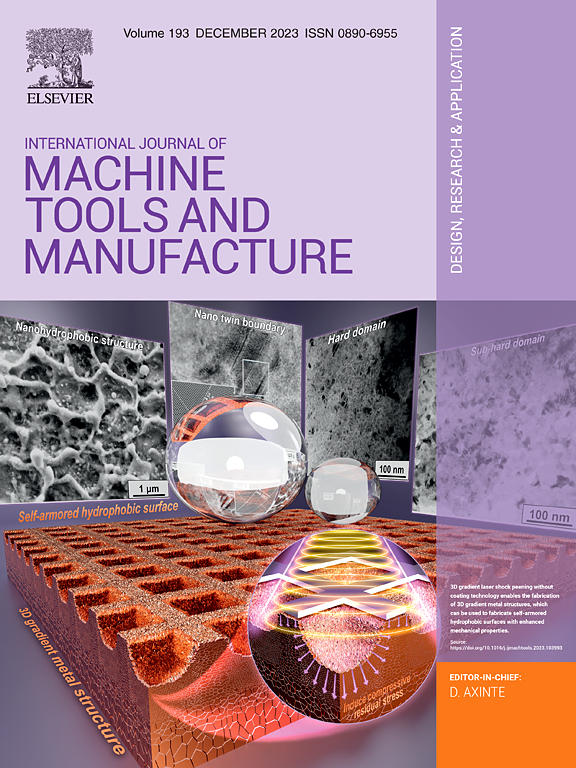Decoupling the heat source and remelting depth for equiaxed transition in wire arc additive manufacturing of titanium alloy
IF 18.8
1区 工程技术
Q1 ENGINEERING, MANUFACTURING
International Journal of Machine Tools & Manufacture
Pub Date : 2025-07-05
DOI:10.1016/j.ijmachtools.2025.104309
引用次数: 0
Abstract
The columnar to equiaxed transition (CET) of grain structures presents significant challenges in titanium alloy additive manufacturing (AM), especially in wire arc additive manufacturing (WAAM) with highly localized heat input and large temperature gradient. In this work, the strategy of decoupling the relationship between heat source and remelting depth was proposed, which was achieved by altering the electrode connection type with arc discharge between the tungsten electrode and the welding wire (IPAW-Wire method). Compared to the conventional WAAM methods based on tungsten inert gas welding (Conventional-TIG method), the IPAW-Wire method reduces the average β grains width from 2 mm to around 200 μm and the maximum texture intensity by approximately three times. The decoupling strategy combined with thermal undercooling and periodic solidification effect of low-frequency pulse arc promotes CET results. The IPAW-Wire method increases tensile strength by 50–80 MPa without altering the alloy composition or making external equipment modifications, and significantly weaken the anisotropy of mechanical properties, both in terms of ultimate strength and plasticity. The strength enhancement and anisotropy reduction are attributed to the coupling of β grains refinement, weakened α crystallographic texture, fine needle-like α′ martensite, and high-density dislocation with multiple types of <a> dislocations, <c> dislocations and <c+a> dislocations. This innovative IPAW-Wire method effectively mitigates coarse columnar grains and anisotropy by decoupling the relationship between heat source and remelting depth. This control strategy can inspire other heat sources and material additive manufacturing process, addressing hotspot challenges such as programmable microstructure, metamaterials structure, multi-material, and bioinspired printing.

钛合金丝弧增材制造等轴转变热源与重熔深度解耦
晶粒结构的柱状向等轴转变(CET)是钛合金增材制造(AM),特别是在热输入高度局域化和温度梯度大的电弧增材制造(WAAM)中面临的重大挑战。本文提出了一种解耦热源与重熔深度关系的策略,该策略通过改变钨电极与焊丝之间电弧放电的电极连接方式(IPAW-Wire法)实现。与传统的钨惰性气体焊接方法(conventional - tig法)相比,IPAW-Wire方法将β晶粒的平均宽度从2 mm减小到200 μm左右,最大织构强度减小了约3倍。结合热过冷和低频脉冲电弧周期性凝固效应的解耦策略促进了瞬变效应的产生。IPAW-Wire方法在不改变合金成分或不进行外部设备改造的情况下,可将拉伸强度提高50-80 MPa,并且在极限强度和塑性方面显著减弱力学性能的各向异性。强度增强和各向异性降低是由于β晶粒细化、α晶体织构减弱、细针状α′马氏体和高密度位错与多种类型的<;混乱,& lt; c>位错和<;c+a>;混乱。这种创新的IPAW-Wire方法通过解耦热源和重熔深度之间的关系,有效地减轻了粗柱状晶粒和各向异性。这种控制策略可以启发其他热源和材料增材制造工艺,解决可编程微结构、超材料结构、多材料和仿生打印等热点挑战。
本文章由计算机程序翻译,如有差异,请以英文原文为准。
求助全文
约1分钟内获得全文
求助全文
来源期刊
CiteScore
25.70
自引率
10.00%
发文量
66
审稿时长
18 days
期刊介绍:
The International Journal of Machine Tools and Manufacture is dedicated to advancing scientific comprehension of the fundamental mechanics involved in processes and machines utilized in the manufacturing of engineering components. While the primary focus is on metals, the journal also explores applications in composites, ceramics, and other structural or functional materials. The coverage includes a diverse range of topics:
- Essential mechanics of processes involving material removal, accretion, and deformation, encompassing solid, semi-solid, or particulate forms.
- Significant scientific advancements in existing or new processes and machines.
- In-depth characterization of workpiece materials (structure/surfaces) through advanced techniques (e.g., SEM, EDS, TEM, EBSD, AES, Raman spectroscopy) to unveil new phenomenological aspects governing manufacturing processes.
- Tool design, utilization, and comprehensive studies of failure mechanisms.
- Innovative concepts of machine tools, fixtures, and tool holders supported by modeling and demonstrations relevant to manufacturing processes within the journal's scope.
- Novel scientific contributions exploring interactions between the machine tool, control system, software design, and processes.
- Studies elucidating specific mechanisms governing niche processes (e.g., ultra-high precision, nano/atomic level manufacturing with either mechanical or non-mechanical "tools").
- Innovative approaches, underpinned by thorough scientific analysis, addressing emerging or breakthrough processes (e.g., bio-inspired manufacturing) and/or applications (e.g., ultra-high precision optics).

 求助内容:
求助内容: 应助结果提醒方式:
应助结果提醒方式:


